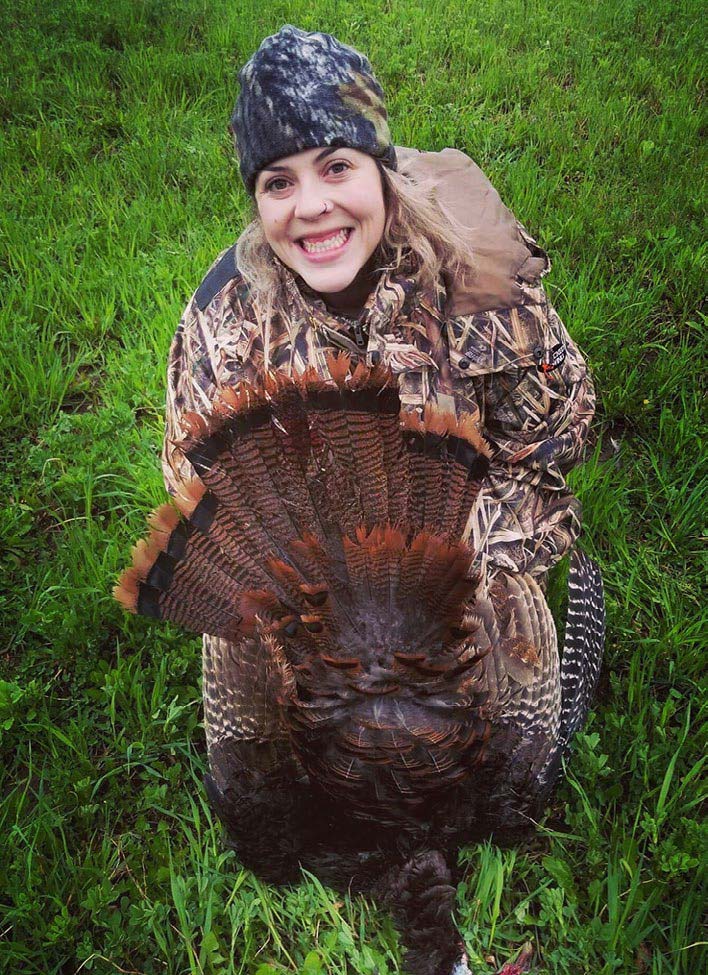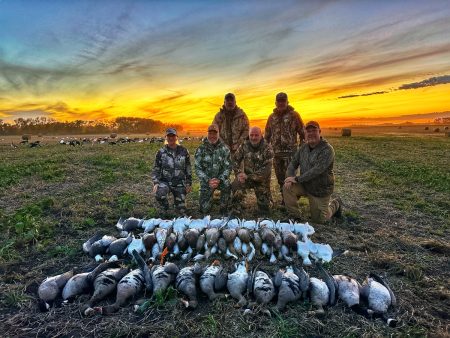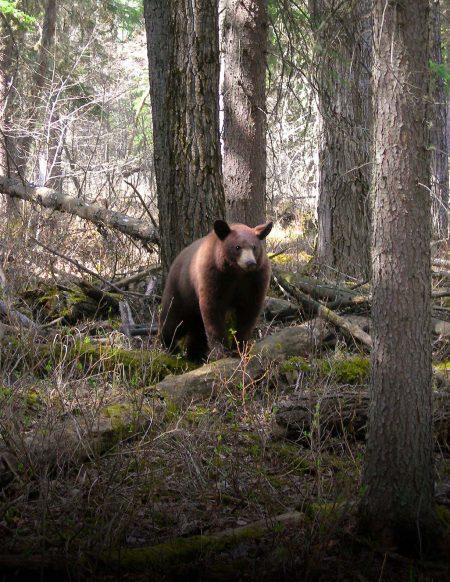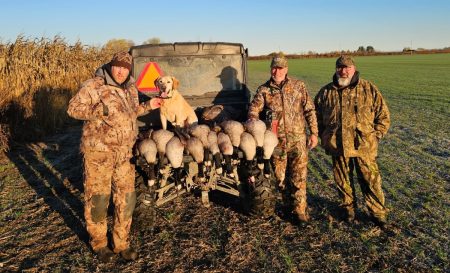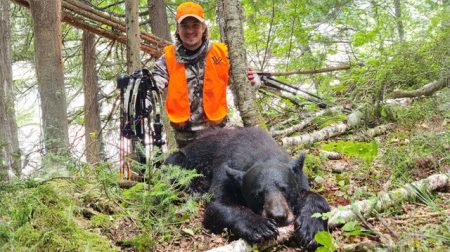I have an obsession. I love wild turkeys. I dream of roosts. I fantasize about calling. Endless parades of thunder chickens march through my mind every spring.
But it wasn’t always this way. As an Alberta girl, my vision of these birds was at one time limited to the barnyard. I saw them as a noisy Picasso of an animal jumbled together with spare parts. I’d never seen the majesty of a gobbling tom emerging from the soupy morning fog or felt the nosey glare of a suspicious hen. And I most certainly never experienced the exhilarating game of Marco Polo that comprises a good turkey hunt. As an avid duck hunter, calling had become one of my favorite aspects of the pursuit, so hearing about the challenge of talking to turkeys eventually became too titillating to resist.
Easterns in Ontario
While they are often called “the poor man’s elk hunt,” there are many tactics to hunting turkeys. Almost all of them involve calling. In Canada, there are two species: Easterns, and in the west, Merriams. Both respond to the same types of calls. These include mouth calls and slate calls to imitate the soft chirps of a hen, or box calls to mimic the gobble of a rival tom. Additionally, decoys are used to play on both the territorial and mating drive of toms.
When I began to entertain the idea of a turkey hunt, I knew none of this. Luckily, a good friend not only lived in Eastern turkey country but also happened to be a renowned guide and someone who had been trying to convince me to harvest a gobbler in his neck of the woods for some time.
After a long journey, I arrived on the doorstep of my treasured bosom buddy, the legendary Barry Keicks. I had allotted only two days to bag a bird before I was due back at work. Without Barry, this was simply not possible, but his permissions were already obtained for the season. All that was left to do was some quick scouting before setting out to hunt. We devoted the evening of my arrival to finding a good group of birds and “putting them to bed” or watching them roost to give us a point for our setup the next morning. This wasn’t hard to come upon in southern Ontario. As we observed our quarry, my interest began to further pique. From a distance, these were not the clumsy critters I had come to expect. These were wild creatures that were wary, sleek and quick.
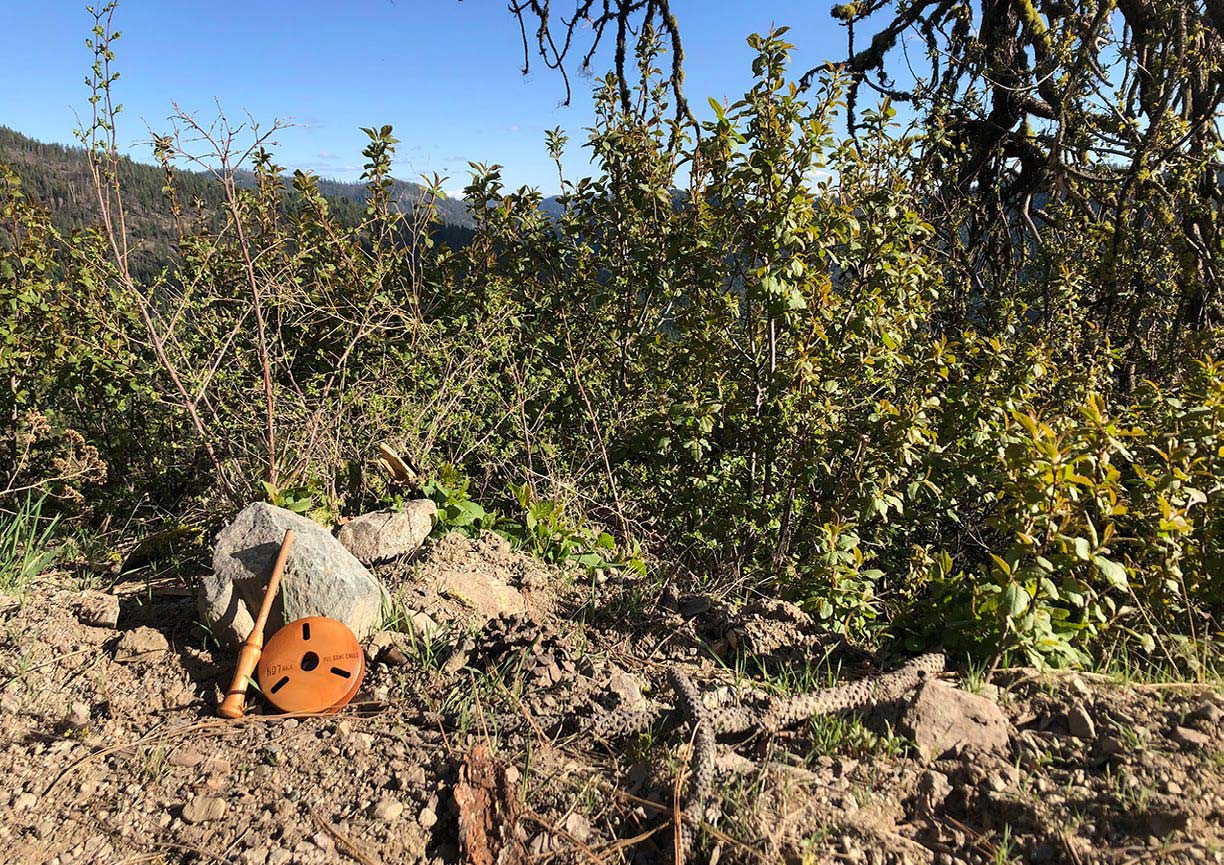
First, Silence
Early the following morning before we walked into the dewy undergrowth, Barry let out a series of crow calls and waited for a response to ensure we weren’t about to unknowingly flush a group of birds. Toms will instinctively gobble back to many loud abrupt noises, such as those made by crows, owls and even car doors slamming. That makes roughly locating them relatively easy to do.
Met by nothing but silence then, we headed in. After settling in near a thick brush pile at the tree line, we waited in the fading darkness. Barry used a mouth call to begin clucking softly. As sure as the tax man, we began to hear them long before we laid eyes on anything. And what a noise! It was both raspy and guttural, sounding completely foreign and yet natural.
As the light gained strength we began to see shapes in the far end of the field; they were trim and brown. Barry identified them as hens. Shortly after that, darker birds followed the ladies out to feed; they were “jakes” or young, immature toms. I had been advised that while jakes don’t hold the mystique and bragging rights of a big tom, jakes are legal to shoot. With so little available time, I would be expected to shoot them if the opportunity arose.
We watched them feed as the fog rose…and then, there he was. Effervescing slowly out of the mist, he was in full strut, fan spread and feathers puffed, gobbling and spitting, and as intimidating as any animal I have encountered. Barry began to gobble with a box call. The jakes perked up their heads. The tom gobbled back. Curious hens moved closer. We held our breath as one picked her way around us, softly “putting” and fixing us with a shiny black eye, daring us to move an inch. While you may not call wild turkeys the smartest animals in the world, they have formidable eyesight, and a wary hen will bust your hide exactly like a snorting doe will. So, the morning progressed with plenty of birds to watch, but the males stayed put safely out of range. They eventually left to roost again mid-day. We left and spent the afternoon scouting more potential areas.
Another Morning
The next morning found us in the same field but closer to the safe zone of the previous days’ birds. Sure enough, out they came at first light, flocked around their magnificent tom. He was even more fired up than the day before and he holed up about 100 yards from our submissive hen decoy with a group of jakes and hens. Then he began to gobble and drum. Drumming was something I wasn’t expecting. It seemed like something other than a noise, almost a feeling deep in the chest. Trying to tempt a “henned up” tom away from his established ladies is notoriously difficult. Eventually, he got bored and followed his cautious lovers to the opposite end of the clearing.
We were running out of time. As soon as I began to doubt any chance of success, the group of jakes decided they might have a slight chance. Maybe the absence of a brutish tom gave them a rush of confidence, and four of them suddenly beelined for our decoy. Barry warned me to stay still and steady as I shouldered the shotgun and watched them approach. They were as sassy as a group of teenage boys.
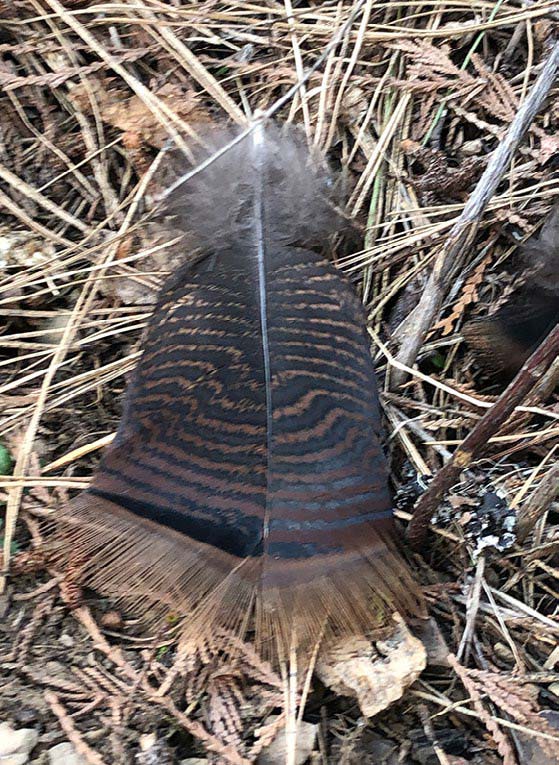
‘Take Him, Girl’
With the words, “take him, girl,” I did. One shot rolled the closest jake to the ground in a ball of feathers. A second mitigated any chance of escape. Curiously enough, the moment my jake hit the ground, the rest of the group descended on him in a fever, pecking and scratching as some instinctual response to his sudden vulnerability. They soon fled on swift legs, followed by a howling Emily, racing giddily out to retrieve her bird.
We laughed and cheered. I gushed and smothered Barry with hugs. While this was not my biggest game, it was one of the finer moments of my hunting career. The tender “turkey strips” Barry fried us for lunch were one of the sweetest meals I’ve shared. I still remember the cozy house, the tingle of my skin warming after a cold morning and the clink of dishes in the kitchen as I dozily reveled in the adventure.
Obsession Takes Hold
That was it. I had the fever. I hung my prized jake foot, complete with a pathetic nub of a spur, on my rearview mirror. I bought a decoy. I acquired several calls, including a traditional wing bone, and I began to practice feverishly, finally settling on a custom slate from PVS Game calls.
Now that I’d had a taste, I was bound and determined to hunt these birds closer to home. This would be easier said than done though, since Alberta is notoriously low on turkeys. Their count is so low that you can wait upward of 10 years to pull a draw. My saving grace lay just over the border in the vast hills and mountains of British Columbia, where the Merriams run thick and the tag is a simple over-the-counter purchase. The only thing left was the “where.” For me, with no local permission or knowledge, this would be a difficult hurdle to overcome.
Merriams in BC
When I asked my turkey guru Barry about Merriams, he was cautious about advising on a species he wasn’t familiar with but offered some simple advice. He advised me to find big roosting timber near water and preferably a spot having a clearing.
I poured over maps, internet forums and magazine articles before choosing a general area. Then, I had to wait out COVID restrictions. Finally, two springs after my Eastern Turkey adventure, it was time to go. I planned to sleep in the truck on public land as I scouted. I packed only clothes, my hunting gear, food and Tony the King for company and moral support. With just five days off and a full-day trip there and back, I had three days to make it happen. With hundreds of unfamiliar kilometers to scout solo and just as many unknowns, this would be a real stretch.
The biggest factor that I hadn’t considered was the progress of spring in the Rockies. With the season only a month long, the earlier part presents difficulty accessing snow-covered logging roads needed for finding prime public land away from other hunters.
The weather also keeps the birds grouped up in the farmland, spots where it is notoriously hard to gain land-use permission. Later in the season, the birds are using the public land in higher elevations, but they are more spread out and are smarter after being pursued for a time.
This particular spring, I had gone out too early. I spent two full days driving the remote logging roads of Southern BC only to be turned around countless times by snow. When I ventured into the arid interior, the roads were clear but the habitat wasn’t suitable.
Luckily, the stunning landscape and abundant wildlife offered consolation around every corner. I just couldn’t be disappointed while surrounded by crystal lakes, majestic mountains and lush farmland. Exploring the country was as exhilarating as the hunt itself. Tony and I had picnics, jumped off docks and took in views from mountain tops. We shared fires with other wayward travelers and curled up in the back seat of the truck every night dreaming of distant gobbles. But by the end of the fourth day, we hadn’t seen or heard a turkey.
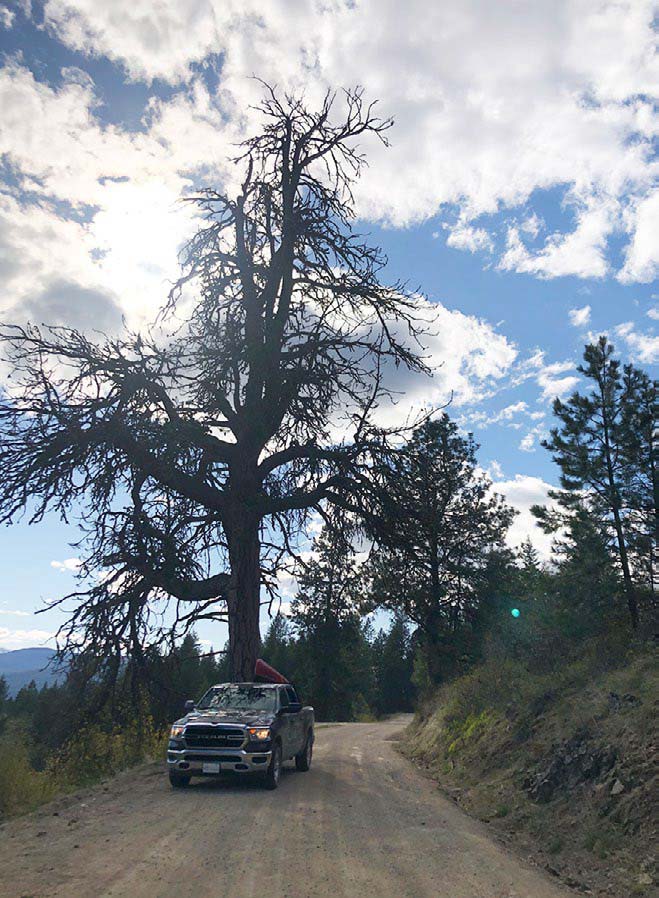
Leaving Defeated?
I began the meandering journey home, replaying the trip in my mind, making adjustments for next time and rehearsing my explanation for this one.
Suddenly, after four days and hundreds of kilometers, there he was on the side of the highway— and in the exact type of habitat Barry told me to find. It was a grassy pasture, bordered by big timber, adjacent to a rushing spring. I didn’t believe it at first. This turkey was glossy and regal. He was shepherding a group of three hens around the pasture to graze, briefly pausing to fan his incredible wedge of a tail.
I wouldn’t be hunting him, though. I had no permission, no hide and no concept of the safe shooting zones. And while I had given up the idea of a turkey dinner, I still needed something.
I pulled off onto a logging laydown and grabbed my new call. If I could get a gobble, that would be enough. The hens sensed the truck and were nervously retreating. I slithered along the tree line until I could see him through a gap. There were maybe 15 seconds left in this encounter, so I stopped and let out five shaky chirps. The gobbler stopped, bristled, and let out the most beautiful gobble I’ve ever heard in my life before disappearing into the ferns! I squealed with glee and scared the birds further away. For the first time on my very own, I’d gotten a call back. Suddenly, after countless miles and doubts, bagging one of these beautiful birds seemed possible again.
I walked back to the truck on a cloud. Across the creek was a logging road I had given up on earlier in the trip. With new knowledge of birds in the area, and still riding the high from my encounter, I had to check it out.
In what little time had passed the road had dried considerably. Not only was I able to travel in, but I also began to see turkey tracks in the fine dirt. During an episode of intense studying the tracks, the brown flash of a hen caused me to slam on the brakes. I took out the call I had pocketed only moments before. For the next 20 minutes, the lone hen and I chatted like old friends. I would chirp and she would walk curiously up to the truck, clucking and cocking her head. Then, startled by Tony’s whining, she’d dive back into the ditch, only to return moments later. Eventually, with my ETA at home now running into the early a.m., I had to leave her. And though I was leaving empty-handed, my heart sang the rest of the way.
Only two hunts in and I was a complete addict. One hunt had given me a taste of victory. The other had taught me the lessons I would need to achieve the next victory on my own. Nothing lurks in one’s mind like the prey that got away. That provided me with both a new respect and an insatiable appetite for the knowledge that is required for success.
So, I continue to scratch the itch, enjoying the process almost as much as a bird in hand. Almost…
Per our affiliate disclosure, we may earn revenue from the products available on this page. To learn more about how we test gear, click here.






